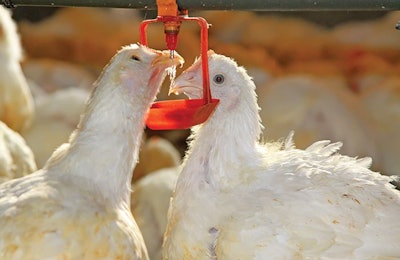
Preventing and removing biofilm from poultry water lines is essential to controlling the spread of pathogens between birds and flocks.
As part of a webinar sponsored by Sterilex and presented by WATT Poultry, Paula Courtney, the director of animal health at Sterliex, spoke about how biofilm is formed, what role it plays in animal health and how it can be avoided. The webinar is available to view on-demand free here.
Courtney said regular water line cleaning and disinfection can strengthen a farm’s biosecurity program, improve animal welfare and improve overall water quality by reducing the microbial load and reducing potential cross contamination between flocks. Cleaning is essential because the drinking water system can be the location with the largest bacterial presence on the farm.
The challenge of biofilm
One of the largest challenges in water quality is the presence of biofilms in water lines.
With the decreasing usage of subtherapeutic antibiotics in the poultry industry, growers are running more products through their water lines such as probiotics, essential oils and organic acids. These products can help create biofilms which serve as a shelter for bacteria and other pathogenic microbes.
A biofilm is a structure of proteins and fats created by bacteria that form in warm, moist environments to act as a natural shelter for pathogens. She said it should be considered a shield used by bacteria to protect itself from the effects of sanitizers and disinfectants. Biofilms also shelter viruses.
Biofilms spread disease, too. Eventually, the bacteria living in the biofilm multiply to a point where their food sources and space are depleted and the film ruptures, allowing the bacteria to spread throughout the entire system. Courtney said this dispersal process is also triggered by disturbances such as flushing a water line or using a chemical treatment that’s ineffective or only partially effective on biofilms.
Removing and killing biofilms
To avoid the problems associated with biofilms, poultry growers should consider using a product designed to attack and remove biofilms.
However, due to biofilm’s role in both human and animal health, she said, any products that claim to deal with biofilms must be registered with the U.S. Environmental Protection Agency (EPA). That registration requires data backing the biofilm-related claims.
When considering which product to use, growers need to look for products that address biofilms, harmful diseases and food safety pathogens according to their EPA registered label. These products carry two different types of claims: biofilm removal and biofilm kill.
Courtney said products labeled for biofilm kill are proven to penetrate and kill biofilm producing bacteria. Biofilm removal products can fully remove the biofilm structure itself, too. Products that kill but do not remove biofilm can allow the bacteria to repopulate in as little as 48 hours.
Courtney cautioned there are some products that can reinforce biofilms rather than remove them. These products do not fully remove the biofilm but rather burn or scar the surface of a biofilm making it more resistant to disinfection. This can happen when using an oxidizing agent like bleach or peroxide.
PerQuat Technology
Sterilex – a company involved in food processing cleaning and sanitation, animal health and live production and water treatment – used a chemical formulation specifically designed to both kill and remove biofilm: PerQuat Technology.
Courntey said Sterilex products using PerQuat Technology are the only products on the market with chemistry designed for, and the specific EPA registration, to both kill pathogens and remove biofilms in drinking lines for animals.
PerQuat Technology is used in the company’s Sterilex Ultra Disinfectant Cleaner Solution 1 and Sterilex Ultra Activator Solution. Courtney said that product line will be known as FortiSolve in 2021. These products are registered as disinfectants with the EPA, shown to be effective against Salmonella, E. Coli, Pseudomonas, avian influenza and other pathogens. They are also non-flammable, compatible with materials used on farms and dyed red to ensure proper product application and flush after use.
Through research conducted at the University of Arkansas, the product was shown to be more effective than competing products such as bleach, citric acid, 35% peroxide solution and 50% silver stabilized peroxide.

















